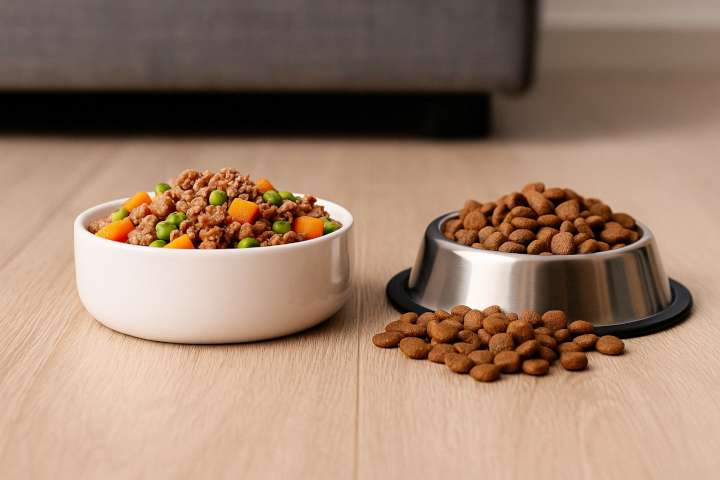Homemade dog food is gaining popularity as pet owners seek more control over what goes into their dog’s bowl. With growing concerns about food quality and ingredient transparency, many are asking: Is homemade dog food better than kibble?
The answer? It depends. Both options have advantages—and drawbacks. Whether you’re considering cooking for your dog or sticking with high-quality commercial kibble, this guide will help you make an informed decision by comparing the real pros and cons of each.
Homemade Dog Food: Pros
✅ Full Ingredient Control
You know exactly what goes into each meal—great for dogs with allergies, sensitivities, or special dietary needs.
✅ No Fillers or Artificial Additives
Homemade meals skip artificial preservatives, colorants, and low-quality fillers commonly found in cheap kibble.
✅ Fresh, Whole Foods
Cooking fresh meat, vegetables, and grains offers higher moisture content and more natural nutrition.
✅ Tailored to Your Dog
You can customize meals for your dog’s age, weight, activity level, and medical conditions.
Homemade Dog Food: Cons
❌ Nutritional Imbalance
Most homemade diets are lacking essential vitamins and minerals if not formulated by a veterinary nutritionist. This can lead to deficiencies over time.
❌ Time-Consuming
Planning, prepping, cooking, and storing dog food requires significant time and effort.
❌ Costly (in some cases)
Quality meats and produce can make homemade feeding more expensive than kibble.
❌ Shorter Shelf Life
Homemade food spoils quickly—must be refrigerated or frozen and used within a few days.
Kibble (Dry Dog Food): Pros
✅ Convenient
Kibble is easy to store, measure, and serve, with long shelf life and less mess.
✅ Complete & Balanced
High-quality kibble is formulated to meet AAFCO nutritional standards and offers a reliable nutrient profile.
✅ Budget-Friendly
There’s a wide range of price points, and feeding kibble is typically more affordable for medium and large breeds.
✅ Dental Health Benefits
Crunchy kibble can help reduce plaque and tartar buildup, though it’s not a replacement for brushing.
Kibble: Cons
❌ Ingredient Quality Varies
Some kibble contains meat by-products, cheap fillers (like corn, wheat, soy), or artificial preservatives.
❌ Lower Moisture Content
Dry food may contribute to dehydration or urinary issues, especially in dogs who don’t drink enough water.
❌ Less Variety
Feeding the same dry kibble every day can become boring for some dogs, leading to picky eating or food refusal.
❌ May Trigger Allergies
Some commercial foods contain common allergens or low-quality proteins that can cause reactions in sensitive dogs.
Which Is More Nutritious?
- Homemade food can be more nutritious if it’s balanced and professionally formulated.
- Kibble is more consistent—you get complete nutrition with less risk of imbalance.
👉 If you want to feed homemade, work with a board-certified veterinary nutritionist to create a complete recipe.
Combination Feeding: The Best of Both Worlds?
Many owners combine kibble + fresh food to improve variety, taste, and nutritional content without going fully homemade.
Examples:
- Kibble base + cooked lean meat or veggies
- Kibble + commercial frozen or fresh toppers (like The Farmer’s Dog or Nom Nom)
- Rotate between kibble and homemade meals (but balance daily calories)
When to Consider Homemade Food
- Your dog has allergies, digestive issues, or skin problems
- You want clean-label, human-grade food
- You’re willing to invest time and consult with a vet
- Your dog is a picky eater who refuses kibble
When Kibble Might Be Better
- You need a budget-friendly, convenient option
- Your dog is thriving on their current diet
- You have a large breed or multiple dogs
- You can’t commit to daily prep and portion planning
Conclusion
Final Thoughts on Homemade Dog Food
Feeding your puppy properly is one of the most important responsibilities you have as a new dog owner. With the right food, schedule, and care, you’ll support their growth and set them up for a long, healthy life.
Not sure which route is right for your dog? Visit our Feeding Comparison Tool to compare recipes, brands, and feeding plans tailored to your pet.

